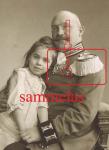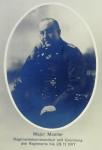-
Posts
2,234 -
Joined
-
Last visited
-
Days Won
55
Content Type
Profiles
Forums
Blogs
Gallery
Events
Store
Everything posted by Glenn J
-
Hi Ingo, 41 years of age is certainly not old for a Prussian infantry captain. Typically, an officer would not be promoted to that rank before his early to mid thirties and then spend ten or eleven years in that rank before promotion to Major or often retirement in that rank at that point if further promotion was not recommended. Regards Glenn
-
Vince, A pretty common name! However, just four artillery Lieutenants with the name Müller had just an EK2 as their sole listed decoration in the 1871 Rangliste. Two of those were Fortress Artillery types which leaves one in the 7. and one in the 8. Artillerie-Brigade. FAR 7 served at both Düppel and Alsen so I would tend towards the then Sekonde-Lieutenant Louis Müller of FAR 7. Do you have any further Information as to the unit he was serving in? Regards Glenn
-
Paul, No, the veterans of 64, 66, 70/71 plus all on active service in the Prussian Army at the time of bestowal. Other odds and sods including the Berliner Schutzmannschaft, non Prussian units serving in Alsace-Lorraine, those involved in the construction of the Kaiser-Wilhelm Memorial etc, etc also got it. Regards Glenn
-
Bethmann was a Generalleutnant à la suite der Armee with uniform of 1. Garde-Dragoner-Regiment. He appears to be wearing the M15 pattern boards for this regiment for a General and the Kleiner Rock. I think Generaloberst v. Moltke's trousers are probably dark grey. He is wearing the M10 pattern Generals' Feldbluse cuffs with the collar litzen of a Generaladjutant. Regards Glenn
-
Paul, as an officer. The appointment as understood in WW1 was created in 1877 to be utilized on mobilization. The incumbents filled lieutenant's positions, initially in replacement, Landwehr and Landsturm units but this was increasingly expanded to include all arms and services at the front. Those appointed were classed as subaltern officers of the Landwehr in the rank of Leutnant but were junior to Leutnants. They exercised the full privileges of commissioned rank without however being subject to the courts of honour system or the necessity to have their promotions confirmed by the unanimous vote of their units officer corps. They additionally had a couple of minor restrictions on clothing; they were not permitted to wear the officers' sash or Feldbinde and although allowed the officers' pattern Paletot (greatcoat), it had the collar of the issued pattern and not the coloured pattern of the officer. Following the end of the war and the introduction of the Republican Government, these guys retired as Leutnant der Landwehr außer Dienst. Those appointed as a Feldwebelleutnant were usually retired former career NCOs although the circle was slightly expanded during the war. Direct promotions of NCOs to commissioned rank was extremely rare. Regards Glenn
-
Charles, In 1914 he was a Major in FAR 61 with an RAO4 and a Long Service Decoration. He became Artillerie-Kommandeur 64 picking up an Hohenzollern House Order 3 with Swords and a Sachsen Ernestine House Order Commander's Cross 2nd Class with Swords on the way. Can't make out the number on his boards but I would assume he would have continued to wear the number 111 as ARKO 64. Regards Glenn
-
Chris, the information I have regarding the award of the HOH3X to officers with the name of Schwerdtfeger in 1918 are as follows: the two dates are the date of publication in the Militär-Wochenblatt and Staatsanzeiger respectively: Hauptmann d.R. Schwerdtfeger: 30 Jul 18, 3 Jul 18 Leutnant d.R. Schwerdtfeger: 26 Oct 18, 25 Sep 18 Leutnant d.R. Ernst Schwerdtfeger: 9 Nov 18, 15 Oct 18 Regards Glenn
-
Matt, It might be useful to see the photograph. However, a couple of possibilities: Hauptmann d.R. Walter Mackenthun who had the EK1 and a BZ3bX but was born in 1882 and Leutnant d.R. Fritz-Boglislaw v. Somnitz who was born in 1885 and entered the Fliegertruppe in 1916, had the EK1 but no Zähringer Lion. Regards Glenn
-
However, in Willi Geile's book listing of HOH3X winners, the two late war winners are both listed as Leutnant d.R. (and one of those was Ernst). An Hauptmann d.R. Schwerdtfeger also won the HOH3X in July 1918. There was an Hauptmann d.R. Schwerdtfeger in FAR 30 but he was Wilhelm Schwerdtfeger. Do you have an exact date for the award? Regards Glenn





